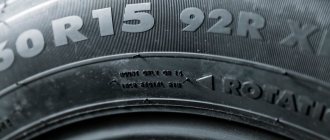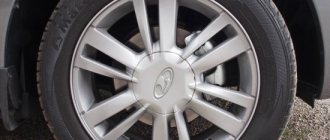It's no secret that tires in a car are subject to the greatest impact, because they are influenced not only by negative external factors (temperature, chemical reagents, friction with the road surface, etc.), but also by the constant load from the mass of the vehicle itself . That is why one of the most important operational parameters is the tire load index, indicated in the markings on the outer side surface of the tire.
Load Index
This parameter is often of interest to drivers of heavy-duty vehicles. This characteristic affects the permissible maximum force applied to one wheel. This indicator is measured in kilograms. The selection of tires should be carried out taking into account this parameter to achieve comfortable and safe driving.
Speed limits and tire loads are interconnected: an increase in speed leads to an increase in the dynamic load on the tires. Therefore, an increase in the speed of movement of a car by 10 km/h must be compensated by reducing weight - up to 5%! Tire manufacturers take this dependence into account. Therefore, tires with a low index do not make a hum while driving, ride softly and smoothly, and products with a high coefficient allow you to increase the stability of the car, while driving comfort decreases.
Table 2. Decoding of the load index
The classification of loads given in Table 2 was developed taking into account the weight of the vehicle; the larger it is, the higher the index for the tire. For example, the number 85 means the effective load on one tire is 515 kilograms. This characteristic, taking into account the carrying capacity of the machine, allows you to calculate the amount of cargo transported.
Exceeding the parameters recommended by the tire manufacturer can lead to loss of vehicle control or tire rupture. For example, marking 91V means:
- the tire speed limit is 240 km/h (see table 1);
- load on one wheel - 615 kg (see table 2).
Tire testing to determine indexes
Behind the formal numbers of tire speed and load indices and dry recommendations from manufacturers there is a large amount of engineering work by designers and testers. The assignment of each tire model to a certain category occurs not only (and even not so much) by calculation methods, but also on the basis of data from bench, field and full-scale rubber tests.
A classic example in this regard is the world famous Nokian, where tires first undergo a cycle of bench tests . The design of the test bench has been known for a long time: the tire under test rotates a massive drum, against which it is pressed with a certain force. Strict adherence to test regimes and constant monitoring of the condition of the tested object are important here.
The second stage is field testing : the car on which the test samples are installed is controlled by a robot and moves along a closed path. At this stage, testers also have the opportunity to constantly monitor the parameters of the tires being tested.
Finally, the third stage is full-scale testing of tires in operation, both by test drivers of the company itself and by independent experts (usually taxi drivers). During full-scale testing, it is not possible to constantly monitor the parameters of the condition of the rubber, but the value of the final result is higher than at previous stages - this is data from actual operation.
We recommend: 10 ways to mount your phone in a car
Nokian, for example, is very demanding on the quality of its products - even if during bench tests a tire can withstand speeds of over 300 km/h for a long time, it is far from a fact that it will be assigned a high-speed tire index and, quite possibly, everything will be limited to the T index .
Tire load and speed index, explanation
In order to buy good car tires, it is not enough to know only their size and seasonality. Of course, this is basic information that the car owner must have; without it it is simply impossible to choose a tire. When choosing tires, some are guided by the brand name and to some extent this is correct. But if you take a tire from the best brand that fits the car and is appropriate for the season, then in this situation you can make a serious mistake, and its consequences can be the most tragic.
What does the marking hide?
Of course, the tread pattern and the cost of tires also largely determine our choice, but the load index and tire speed, the explanation of which will be presented below, play a much larger role. On the side surface of each wheel, even the most inexpensive one, there is a bunch of various information that is hidden in symbols and numbers; its importance should never be underestimated.
For example, from this encryption you can find out the following information:
- Tire model and tread type. This is very important information, since each tread type corresponds to a certain hardness of the rubber material. A tire of the same model, but with a different type of tread, may have different stiffness of the central and lateral parts of the contact area.
- The most famous inscription is the tire size, its seat diameter, height, width (height to width ratio).
- Tire production date.
- Designation of design type (radial or diagonal), tire type (tube, tubeless).
- Wheel rotation direction.
- Speed index.
- Load index.
The largest letters, of course, bear the manufacturer’s name and logo, which is what people pay attention to first.
Why know the load index?
In each country where tires are produced, the load index can be called differently, such as load index, maxload, load capacity index, but the meaning does not change. Moreover, the load is indicated not by a number, but by a letter, which most often misleads inexperienced motorists. Also, many people believe that this information is important mainly for truck tires, but this is completely wrong. This indicator plays a huge, if not even greater, role for passenger tires, motorcycles, mopeds, and here’s why.
Simply put, this is the maximum load on one wheel, at which the manufacturer guarantees the preservation of the characteristics of the rubber. The load is indicated in kilograms, and at the maximum permissible speed for the tire and if the optimal pressure is maintained. But what about working conditions, weather, lateral load, driving style, technical condition of the car, this will also affect the endurance of the rubber? Of course, that's the whole point.
Index tables and how to use them
Everything seems to be simple. Here is a table of tire load index (Table 1), here is a table of permissible speed load (Table 2). These values are exactly the same for all manufacturers and are standardized throughout the world. The letter (or number) indicates the index, and the table indicates the load value in kilograms. All that remains is to calculate the load on one wheel and buy tires that match the index.
We recommend: Low profile tires, advantages and disadvantages
But the fact is that we can hardly calculate the exact load on the wheel. It is not enough to simply divide the mass of the car by four. Firstly, the load on the front and rear axles will be completely different, and secondly, a number of other conditions constantly intervene:
- surface temperature of the rubber material;
- instantaneous speed of the machine;
- how badly the wheel is worn;
- dependence of pressure on temperature.
And the list goes on. It is for this reason that the manufacturer gives a safety margin of 25-30%! And the driver should add the same amount when buying a wheel. However, in choosing a tire, the last word will always remain with the car manufacturer, who calculated the load capacity index not with a calculator in hand, but based on the results of lengthy tests.
Dependence of speed and load indices
The second table, presented just above, shows the maximum speed index. By analogy with the load index, the tire does not have a number, but a letter symbol. It seems that everything is simple here too - I looked at the letter, compared it with the data in the table, and bought tires. All that remains is not to exceed the permissible speed. Only here everything is not so smooth. Both indicators greatly influence not only the car’s handling and its load capacity, but also the comfort of movement in the cabin. After all, the harder the tire, the lower the speed index, and the softer the tire, the less load it can withstand.
Therefore, both indices are closely intertwined with each other, and this is not counting the roads on which we have to drive, and this fact again refers us to the car manufacturer. He tested the car, only he knows what maximum values the wheel should withstand.
Ideally, it would be good to start from the parameters of the tires that were installed on the car from birth, from the assembly line. However, no one bothers you to independently analyze the rate of tire wear and comfort in the cabin, handling and adequacy of prices. Therefore, the more we know about our tires, the more comfortable and safe it will be to use them. Good choice, velvet roads to everyone!
Why pay attention to the load and speed index
From the above data, you may get the impression that you need to buy tires that have maximum load and speed ratings. This opinion is erroneous, and in each situation the driver must individually choose the appropriate kit for himself according to these parameters.
The lower the maximum speed and load a tire can withstand, the softer it is. The hardness of the rubber directly affects the comfort of being in the cabin while the car is moving, as well as controllability. Accordingly, if the driver operates the car in the city and rarely reaches high speeds, it is better for him to choose softer tires for a comfortable ride. In each case, the optimal parameters depend on the conditions and manner of operation of the vehicle.
( 431 votes, average: 4.53 out of 5)
How to choose used tires that will last for several seasons?
How to change a tire yourself
Related Posts
What is a load index?
This index gives an idea of the maximum load that a tire can withstand while maintaining all its characteristics. Usually this is the weight of the vehicle divided by four, but there are nuances (for front and rear axles, for example), which is why when choosing tires you should leave a small margin in the load index.
Many believe that the parameter under consideration is important exclusively for freight transport. However, it is not. Drivers of passenger cars should also understand that a higher index value indicates increased requirements for the materials used in the production of this rubber model.
But let's get back to the labeling. Let's take, for example, the designation 205/55 R16 91V. As already mentioned, the indices we are considering are located after the tire size. In this case, it is “91V”, where “V” is the speed index, and “91” is the load index, which shows that the manufacturer’s recommended weight per wheel should not exceed 545 kilograms (see table).
It is impossible to select suitable tires without taking into account the decoding of load indices and tire speeds.
Please note: the tire size and indexing for a specific car are indicated by the car dealer. This information can be found in the vehicle's operating instructions. Tire manufacturers cannot indicate these parameters by car brand.
We recommend: Advantages and disadvantages of all-season tires
When choosing tires, study the information specified in the car manual, the driving style of the vehicle, and the operating conditions of the vehicle. For example, purchasing tires with a maximum speed index for urban operating conditions is inappropriate; such a purchase will lead to a deterioration in driving comfort and such tires will cost more.
Tire load index decoding
Decoding the tire load index is possible only thanks to special tables, such as “Tire load index decoding” (presented on this page above) or with the help of consultants from car tire stores, who must provide any information of interest on the product offered. When choosing suitable tires, you need to pay attention to the fact that the higher the tire load index is from that recommended by the car manufacturer, the less driving comfort remains due to the increase in rigidity and strengthening of the tire sidewall to withstand the weight determined by the load index. It is also not worth underestimating the wheel load index recommended by the car manufacturer; in this case, the comfort of movement will be greater, but the level of passive safety will be reduced.
Source runettest.ru
Tire speed index
The definition of the tire speed index can be given in a simple way - this is the maximum speed that the tire can withstand. Another thing is what is meant by the term “withstands.” Of course, first of all, these are clear conditions of use:
- Tire pressure,
- Vertical load,
- Environmental parameters (coating quality, weather conditions).
Under comparable conditions of use, the speed index is a kind of guarantee from the manufacturer that, at the declared maximum speed, the tire will retain its physical and mechanical properties and will not collapse.
When marking, the tire speed index is indicated by one of the letters of the Latin alphabet, which immediately follows the load index. To decipher it, they usually also use a table.
Tire Speed Index Table
| Speed index | Permissible speed, km/h | Speed index | Permissible speed, km/h |
| A1 | 5 | K | 110 |
| A2 | 10 | L | 120 |
| A3 | 15 | M | 130 |
| A4 | 20 | N | 140 |
| A5 | 25 | P | 150 |
| A6 | 30 | Q | 160 |
| A7 | 35 | R | 170 |
| A8 | 40 | S | 180 |
| B | 50 | T | 190 |
| C | 60 | U | 200 |
| D | 65 | H | 210 |
| E | 70 | V | 240 |
| F | 80 | W | 270 |
| G | 90 | Y | 300 |
| J | 100 | ZR | more than 240 |
The table is easy to remember: the letters are arranged alphabetically with the exception of one – H (corresponding to a speed index of 210 km/h).
Sometimes (quite rarely lately) you can find tires without speed index markings. As a rule, these are tires for sports cars, designed for specific models (sometimes for individual cars), which are not installed on production cars.










